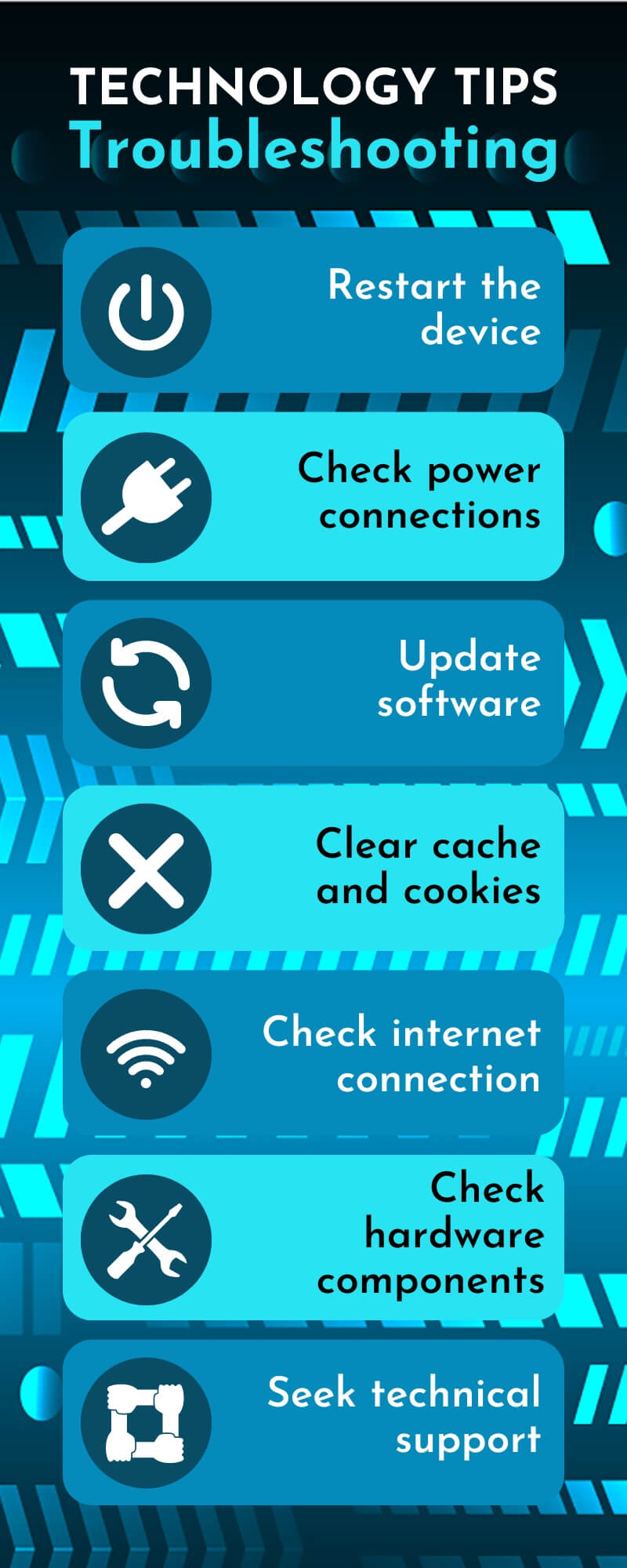Hey there, tech warriors! I’m confident we’ve all been there – struggling to get a stuck computer to unfreeze, struggling with a Wi-Fi signal you can’t easily reach, or just trying to get a printer to work as it should, which is to print. Wow, technology can be such a pain in the neck sometimes, or in this case, it is in the rear specifically. But do not despair just yet. Here is a promising list of valuable tips that will help you to become the master of the instant troubleshooting of tech failures. Let’s get it on and teach those gadgets a lesson they’ll never forget!
Restart: The Magic Button
First up on our troubleshooting hit list – the almighty restart.
I know what you’re thinking. Really? Turn it off and on again? That’s your big secret?”
But hear me out. This simple trick is often the unsung hero of the tech world. Here’s why:
It clears out the device’s temporary memory (RAM), giving it a fresh slate.
Any minor software glitches get the boot.
Background processes that might be causing issues are terminated.
Therefore, if you are unsatisfied with one of these solutions, turn to a more straightforward solution and reboot your device. It is like waking up from a power nap with total energy to work. That is, wake up the technology and set it to work.
Pro tip: A “soft reset” (turning off and on) is usually enough for smartphones and tablets. But for computers, go for a total shutdown. Wait about 30 seconds before powering up again to ensure all capacitors are fully drained.
Enjoy the convenience of Poorvika online shopping for mobiles and accessories.
Power Problems? Not on My Watch!
Now it’s time to discuss the P: power. Arguably, power is the most elementary issue, and surprisingly, it is often the root of many tech problems.
Here’s your power checklist:
- Check all power cables and connections. Wiggle them a bit to ensure they’re snug.
- Look for any frayed cords or bent prongs.
- If you use a power strip or surge protector, ensure it’s switched on.
- For laptops and mobile devices, try a different charging cable if possible.
The end of the cables proves that not all wires used for charging are the same. It is always essential to use a suitable cable. Charging with a low-quality or faulty cable might slow the charging process or harm the device. Use chargers that are recommended by the manufacturer as much as possible.
Software Update: The Unsung Hero
Okay, we are in a position to discuss software updates. Right. Well, you know what they say – never the twain – always turn up at the most inconvenient time. But of course, there must always be a reason for the madness: it does not stop being organized.
Why updates matter:
- They patch security vulnerabilities, keeping your data safe from the bad guys.
- Bug fixes can resolve issues you might be experiencing.
- New features can improve your device’s performance and functionality.
Here’s the deal: Set aside some weekly time to check for and install updates. It’s like taking your tech to the gym –regular maintenance goes a long way.
Clear the Clutter: Cache and Cookies
It’s time for some digital decluttering! Your browser’s cache and cookies are like that junk drawer in your kitchen—helpful for storing stuff but can get messy quickly.
What’s the deal with cache and cookies?
- Cache: Temporary files stored by your browser to load websites faster.
- Cookies: Small bits of data that remember your preferences and login info.
While they’re meant to improve your browsing experience, they can sometimes cause issues:
- The outdated cache can make websites behave strangely.
- Corrupted cookies might prevent you from logging into sites.
How to clear them:
- Open your browser settings.
- Look for privacy or history options.
- Choose to clear browsing data.
- Select cache and cookies (and anything else you want to clear).
- Hit that clear button!
Remember, you might need to log back into some sites after this digital spring cleaning.
Internet Issues? Let’s Investigate
Ah, internet problems – the bane of our modern existence. When your connection starts acting up, try these steps:
- Check other devices: It could also be specific to the device. For instance, your phone is perfectly okay, but your laptop is slow.
- Restart your router: Turn it off; yes, you know how that feels: deeply unsettling; wait for 30 seconds, or it feels like an eon; then turn it back on.
- Check for service outages: You will find out more about the outages from your ISP’s website or even on their application, which they may have.
- Try a wired connection: If Wi-Fi is the issue, plug your PC directly into your router using an Ethernet cable.
- Run a speed test: Websites such as speed test. Net can assist you in knowing the speeds to which you subscribed.
Even if you consistently receive substandard internet speeds, it may be time to talk to your ISP. The people you pay to work for you should not be leading you around in circles – you are paying them for that job, remember?
Hardware Check: The Deep Dive
Sometimes, the problem goes deeper than software. It’s time to get hands-on with your hardware:
- Check for loose components: Open up your desktop (if you’re comfortable) and ensure everything’s seated properly.
- Clean out dust: Dust can cause overheating. A can of compressed air works wonders.
- Listen for unusual noises: Clicking or grinding sounds from your hard drive? That’s a red flag.
- Monitor temperatures: Overheating can cause all sorts of issues. Use software like Core Temp to keep an eye on things.
Remember, if you’re not comfortable poking around inside your device, there’s no shame in calling in a pro. Better safe than sorry!
The Lifeline: Technical Support
When all else fails, it’s time to call in the cavalry. Don’t be shy about reaching out to technical support. They’ve seen it all, and they’re there to help.
Tips for a smooth support experience:
- Be prepared: Have your device info, serial numbers, and a clear problem description ready.
- Be patient: They might ask you to try things you’ve already done. Go along with it – they’re following a script to cover all bases.
- Take notes: Write down any steps they have you take. It could come in handy later.
Remember, a good support team can be your best ally in solving tricky tech issues.

FAQs:
Q: As directed to the program and the specific devices, the general question was: How frequently should I reboot my devices?
A: Ideally, you should perform this task once a week, but if you see that the activity has decreased, it is recommended to do it more frequently.
Q: Can I clear the cache and cookies?
A: Absolutely! Only be careful that you may have to re-sign into some of the sites subsequently.
Q: Can old software create that much trouble?
A: You bet! Fixing an old software version is one of the easiest ways to avoid these problems and enhance performance.
Q: What are some of the preventive measures that I can take to enhance the performance of these instruments?
A: Washing: The amount depends on many factors, and the most important is the need to wash the car regularly. Delete unused applications and files, and refresh the devices’ operating systems occasionally.
Q: When should I seek to replace a device rather than have it repaired?
A: If repair costs are akin to purchasing a new gadget, it is advisable to replace them if the gadget is over 3-4 years old or faulty.
Conclusion:
Well, there you have it, folks; this is how you can start conquering those tech troubles like a boss. However, remember this – technology is there to ease our lives and not make us have more headaches. Now, these shall be your fortunes: With these tips, the next time you face an operating system problem or any technical difficulty, you shall solve it quickly.
Is there any other stock genius for cheating the system that you would like to share with us? Sub them in the comments – while in technology, sharing is caring. Oh, and the last one, if I may add, a little patience can take you a long way when in doubt. Happy troubleshooting!
Also Read:




